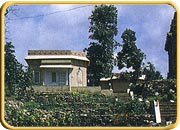Orchha
Places of Interest in Orchha

Dinman hardaul's Palace : hardaul was a son of Bir Singh Ju and died to prove his innocence to his elder brother Jhujhar who cast doubts on his relationship with his (jhujhar's) consort. This saintly prince was, after his martyrdom, worshipped as a god, and even today, the villages of Boundelkhand contain platform-like shrines where hardaul is worshipped.
Chhatries (Cenotaphs) : There are fourteen 'chhatries' of memorials to the rulers of Orchha, grouped along the Kanchana Ghat of the river Betwa.
Sunder Mahal : This small palace, almost in ruins today, is still a place of pilgrimage for Muslims Dhurjban, son of Jhujhar, embraced Islam when he wed a Muslim girl at Delhi. He spent the latter part of his life in prayer and meditation and came to be revered as a saint.
Shahid Smarak : Commemorates the great freedom fighter Chandrashekhar Azad who lived and worked in hiding on Orchha during 1926 and 27. Chaturbhuj Temple : Built upon a massive stone plat form and reached by a steep flight of steps, the temple was specially constructed to enshrine the image of Prakash that remained in the Prakash Raja Temple. Lotus emblems and other symbols of religious significance provide the delicate exterior ornamentation. Within, the sanctum is chastely plain with high, vaulted walls emphassing its deep sanctity.

Laxminarayan Temple : A flagstone path links this temple with the Ram Raja Temple. The style is an interesting synthesis of fort and temple moulds. The interiors contains the most exquisite or Orchha's wall paintings. Covering the walls and ceiling of three halls, these murals are vibrant compositions and cover a variety of spiritual and secular subjects. They are in an excellent state of preservation, with the colours retaining their vivid quality.
Phool Bagh : Laid out as a formal garden, this complex testifies to the refined aesthetic qualities of the Bundelas. A central row of fountains culminates in an eight-pillared palace-pavilion. A subterranean structure below was the cool summer retreat of the Orchha kings. An ingenious system of water ventilation connected the underground palace with Chandan Katora, a bolw-like structure from whose fountains droplets of water filtered through to the roof, simulating rainfall.
Select a holiday with us